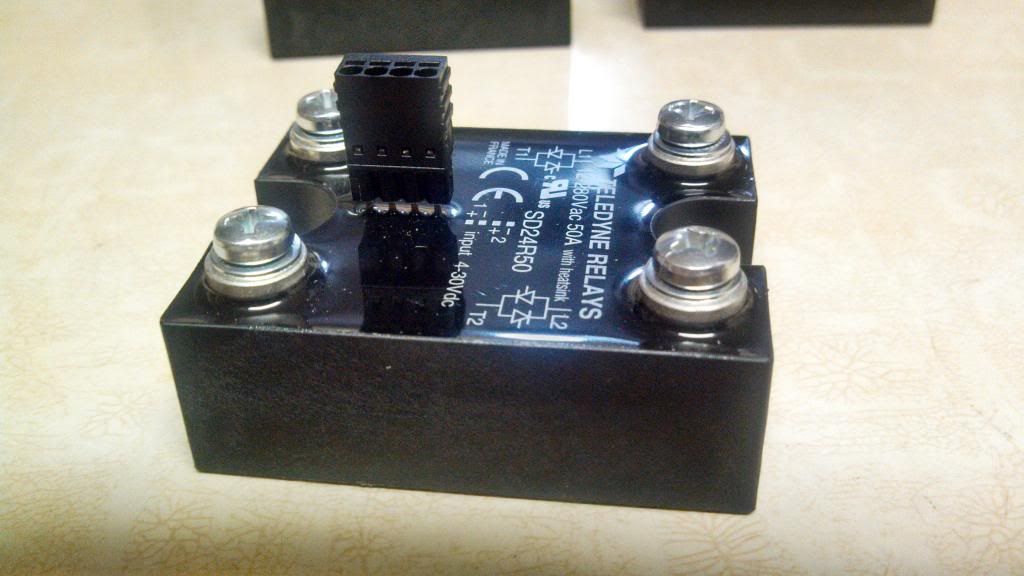Before I built my 50 Amp e-HERMS panel, I spent a lot of time looking at designs that were posted on this sight, particularly PJs. I thought using circuit breakers within the panel, as well as contactors, was a little overkill....but based on what I was already spending, decided to keep them in the design.
I bought 40Amp FOTEK SSRs and didn't initially have a problem. After a couple of batches, I set my temp for the strike water at the beginning of my brew day, and then went about my normal preps. I returned to find that I had blown through the temperature and my strike water was 185 degrees. I used the contactor to kill power to the element, added some cold water to reach my strike temp and then re-energized the circuit. The BCS 462 maintained temperature for the rest of the day...without runaway temps.
On subsequent brew days, I continued to have the same problem. I verified that the 5V DC input from the BCS was appropriate, but the SSR was sticking open during the initial heating of strike water in my BK or getting my HLT to initial mash temp. If I killed the circuit with the contactor, the SSR would reset and didn't stick when energized for small temperature changes or maintaining HERMS temps.
I changed out the 40Amp FOTEK with another 40Amp FOTEK. I had good results for 3 brew days, and then started to experience the same symptoms. I hadn't gotten around to ordering new SSRs from Auber, and figured I could live with the sticky SSRs for a little while. With all the other projects I have going on...a little while turned into 6 months.
2 weeks ago, I was heating strike water in the BK and getting my HERMS water in the HLT up to temps at the same time. After 20 minutes of heating, the circuit breaker for the HLT popped. I looked inside, could smell something hot, but didn't see a problem. I continued the brew day, resetting both SSRs when the initial temperatures were reached and didn't have any further problems.
The next day, without the rush to get things done, I could see a little deformation of the HLT SSR. If I had seen it when I popped the CB, I would have called it a day.
My 40 Amp FOTEK running my fermentation chamber hasn't had any problems at all. I am making an assumption that the lower volts and amps aren't great enough to make the SSR stick....at least not yet.
3 out of 3 40Amp FOTEK SSRs installed on 25Amp circuits experienced sticking while bringing strike and heat exchange water up to initial temps.
A big fan of contactors and multiple circuit breakers in the panel....they have already paid for themselves.
Not a big fan of FOTEK.........I just switched to Auber.


I bought 40Amp FOTEK SSRs and didn't initially have a problem. After a couple of batches, I set my temp for the strike water at the beginning of my brew day, and then went about my normal preps. I returned to find that I had blown through the temperature and my strike water was 185 degrees. I used the contactor to kill power to the element, added some cold water to reach my strike temp and then re-energized the circuit. The BCS 462 maintained temperature for the rest of the day...without runaway temps.
On subsequent brew days, I continued to have the same problem. I verified that the 5V DC input from the BCS was appropriate, but the SSR was sticking open during the initial heating of strike water in my BK or getting my HLT to initial mash temp. If I killed the circuit with the contactor, the SSR would reset and didn't stick when energized for small temperature changes or maintaining HERMS temps.
I changed out the 40Amp FOTEK with another 40Amp FOTEK. I had good results for 3 brew days, and then started to experience the same symptoms. I hadn't gotten around to ordering new SSRs from Auber, and figured I could live with the sticky SSRs for a little while. With all the other projects I have going on...a little while turned into 6 months.
2 weeks ago, I was heating strike water in the BK and getting my HERMS water in the HLT up to temps at the same time. After 20 minutes of heating, the circuit breaker for the HLT popped. I looked inside, could smell something hot, but didn't see a problem. I continued the brew day, resetting both SSRs when the initial temperatures were reached and didn't have any further problems.
The next day, without the rush to get things done, I could see a little deformation of the HLT SSR. If I had seen it when I popped the CB, I would have called it a day.
My 40 Amp FOTEK running my fermentation chamber hasn't had any problems at all. I am making an assumption that the lower volts and amps aren't great enough to make the SSR stick....at least not yet.
3 out of 3 40Amp FOTEK SSRs installed on 25Amp circuits experienced sticking while bringing strike and heat exchange water up to initial temps.
A big fan of contactors and multiple circuit breakers in the panel....they have already paid for themselves.
Not a big fan of FOTEK.........I just switched to Auber.





